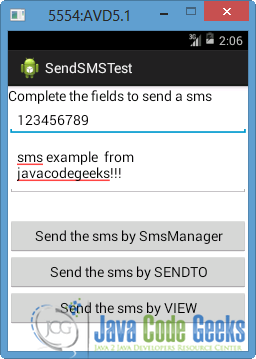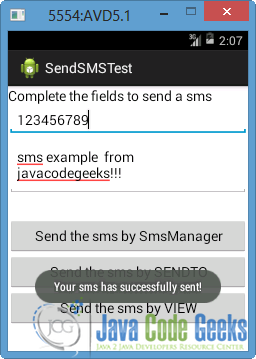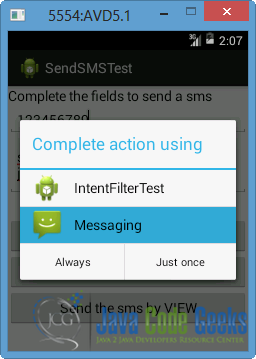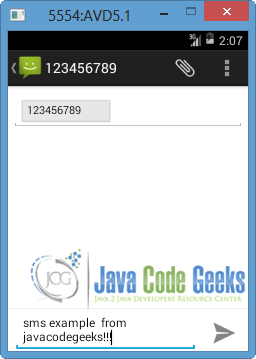In some situations, we want to send sms messages from our own Android application. There are two different ways to do such a thing:
The use of facilitates the sms sending because it gives us the opportunity to customize this functionality with the manner we want, within our own . In parallel, the use of implies the use of built-in applications and sms clients that are installed in each Android device. In this example, we are going to implement both ways. More specifically, we are going to send a sms by using and with action and/or action.
2. Create the layout of the Main Activity
We will put two so that the user can fill in a phone number and a message for a SMS. Also, we are going to add three different , that each one enables a different action and uses a suitable class (, with action, with action).
Open and go to the respective xml tab. Then paste the following.
activity_main.xml:
|
3. Code the Main Activity
handles SMS operations and method should be called, in order to get an instance of this object. For the intent with we have to define the data as and the phone number added at the end. Respectively, for the intent with we will define the type as , so only sms-mms providers will launch. Also, we have to add the phone number and the message as extra fields to that intent.
Open and paste the following.
MainActivity.java:
package com.sbg.android.sendsmstest;
import android.app.Activity;
import android.content.Intent;
import android.net.Uri;
import android.os.Bundle;
import android.telephony.SmsManager;
import android.view.View;
import android.view.View.OnClickListener;
import android.widget.Button;
import android.widget.EditText;
import android.widget.Toast;
public class MainActivity extends Activity {
private EditText phoneNumber;
private EditText smsBody;
private Button smsManagerBtn;
private Button smsSendToBtn;
private Button smsViewBtn;
@Override
public void onCreate(Bundle savedInstanceState) {
super.onCreate(savedInstanceState);
setContentView(R.layout.activity_main);
phoneNumber = (EditText) findViewById(R.id.phoneNumber);
smsBody = (EditText) findViewById(R.id.smsBody);
smsManagerBtn = (Button) findViewById(R.id.smsManager);
smsSendToBtn = (Button) findViewById(R.id.smsSIntent);
smsViewBtn = (Button) findViewById(R.id.smsVIntent);
smsManagerBtn.setOnClickListener(new OnClickListener() {
public void onClick(View view) {
sendSmsByManager();
}
});
smsSendToBtn.setOnClickListener(new OnClickListener() {
public void onClick(View view) {
sendSmsBySIntent();
}
});
smsViewBtn.setOnClickListener(new OnClickListener() {
public void onClick(View view) {
sendSmsByVIntent();
}
});
}
public void sendSmsByManager() {
try {
// Get the default instance of the SmsManager
SmsManager smsManager = SmsManager.getDefault();
smsManager.sendTextMessage(phoneNumber.getText().toString(),
null,
smsBody.getText().toString(),
null,
null);
Toast.makeText(getApplicationContext(), "Your sms has successfully sent!",
Toast.LENGTH_LONG).show();
} catch (Exception ex) {
Toast.makeText(getApplicationContext(),"Your sms has failed...",
Toast.LENGTH_LONG).show();
ex.printStackTrace();
}
}
public void sendSmsBySIntent() {
// add the phone number in the data
Uri uri = Uri.parse("smsto:" + phoneNumber.getText().toString());
Intent smsSIntent = new Intent(Intent.ACTION_SENDTO, uri);
// add the message at the sms_body extra field
smsSIntent.putExtra("sms_body", smsBody.getText().toString());
try{
startActivity(smsSIntent);
} catch (Exception ex) {
Toast.makeText(MainActivity.this, "Your sms has failed...",
Toast.LENGTH_LONG).show();
ex.printStackTrace();
}
}
public void sendSmsByVIntent() {
Intent smsVIntent = new Intent(Intent.ACTION_VIEW);
// prompts only sms-mms clients
smsVIntent.setType("vnd.android-dir/mms-sms");
// extra fields for number and message respectively
smsVIntent.putExtra("address", phoneNumber.getText().toString());
smsVIntent.putExtra("sms_body", smsBody.getText().toString());
try{
startActivity(smsVIntent);
} catch (Exception ex) {
Toast.makeText(MainActivity.this, "Your sms has failed...",
Toast.LENGTH_LONG).show();
ex.printStackTrace();
}
}
}
|
4. Set the SMS Permission
We should set as permission in the file, in order to send an SMS via our application. At this point, we should mention that the permission must be defined for , but it is not necessary for the .
Open file and go to the respective xml tab. Then paste the permission , as you can see below.
AndroidManifest.xml:
<?xml version="1.0" encoding="utf-8"?>
<manifest xmlns:android="http://schemas.android.com/apk/res/android"
package="com.dfd.android.sendsmstest"
android:versionCode="1"
android:versionName="1.0" >
<uses-sdk
android:minSdkVersion="8"
android:targetSdkVersion="19" />
<uses-permission android:name="android.permission.SEND_SMS" />
<application
android:allowBackup="true"
android:icon="@drawable/ic_launcher"
android:label="@string/app_name"
android:theme="@style/AppTheme" >
<activity
android:name="com.javacodegeeks.android.sendsmstest.MainActivity"
android:label="@string/app_name" >
<intent-filter>
<action android:name="android.intent.action.MAIN" />
<category android:name="android.intent.category.LAUNCHER" />
</intent-filter>
</activity>
</application>
</manifest>
|




No comments:
Post a Comment